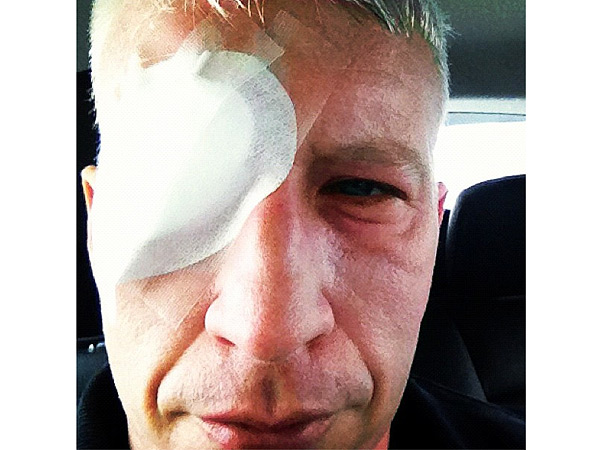Anderson Cooper Burns His Eyeballs

Anderson Cooper has had a number of “close calls” as a reporter for CNN and 60 Minutes.
But a recent trip to Portugal for a 60 Minutes story had Cooper in the emergency room for an usual reason.
Anderson had spent 2 hours out on the water for the story. He woke up in the middle of the night with his eyes “on fire,” and he was unable to see. Physicians determined that he had “sunburned his eyes” from the UV light being reflected off of the water. (NOTE: He was NOT wearing sunglasses)
Anderson tweeted this photo by instagram.
Fortunately, the blindness resolved over the next 36 hours. NBC News Chief Medical Editor Dr. Nancy Snyderman told Cooper:
You burned your retina. This is a real reminder [that people] need to wear sunglasses.
How do you burn your eyeballs?
The injury Anderson Cooper experienced is called photokeratitis (PK). It is also known as ultraviolet keratitis, snow blindness, arc eye or welder’s flash.
It is a painful eye condition caused the an intense exposure of unprotected eyes to ultraviolet (UV) rays. The UV exposure can come from natural or artificial sources. Natural sources include bright sunlight reflected from snow or ice or, less commonly, from sea or sand.
Photokeratitis caused by exposure to sunlight reflected from ice and snow, particularly at elevation, is commonly called snow blindness. Arc eye is the term for the injury in welders who fail to use adequate eye protection such as an appropriate welding helmet or welding goggles. PK can also occur when using tanning beds without proper eyewear.
Photokeratitis is essentially a sunburn of the cornea and conjunctiva (not the retina as stated by Dr. Snyderman), and is not usually noticed until several hours after exposure.
Symptoms include increased tears and a feeling of pain or burning in the eyes. Sufferers feel like they have sand in their eyes. The whites of the eyes (conjunctiva) may also look red.
The condition is usually treated by removal from the source of UV light and administration of pain relief, topically and orally. Putting a patch over the eye restricts its movement, which helps with pain and healing. The injury typically heals within 48 hours of the exposure.
The injury may be prevented by wearing eye protection that blocks most of the ultraviolet radiation, such as welding goggles with the proper filters, a welder’s helmet, sunglasses rated for sufficient UV protection, or appropriate snow goggles.
Did you know? (Source: EPA)
- Long-term exposure to UV radiation can lead to cataracts, skin cancer around the eyelids, and other eye disorders.
- 22.3 million Americans have cataracts (many of which can be prevented by proper UV protection).
- The direct medical costs of cataracts are $6.8 billion annually
- The greatest amount of UV protection is achieved with a combination of: sunglasses that block 99–100 percent of both UV-A and UV-B rays; a wide-brimmed hat; and for those who wear contact lenses, UV-blocking contacts. Wrap-around sunglasses and wide-brimmed hats add extra protection because they help block UV rays from entering the eyes from the sides and above.
- You should wear sunglasses every day, even on cloudy days. Snow, water, sand, and pavement reflect UV rays, increasing the amount reaching your eyes and skin.
- As long as the label says that the glasses provide 99–100 percent UV-A and UV-B protection, you don’t have to buy expensive sunglasses.
- Not all contact lenses offer UV protection and not all provide similar absorption levels. Add sunglasses to improve protection.



























1 Comment